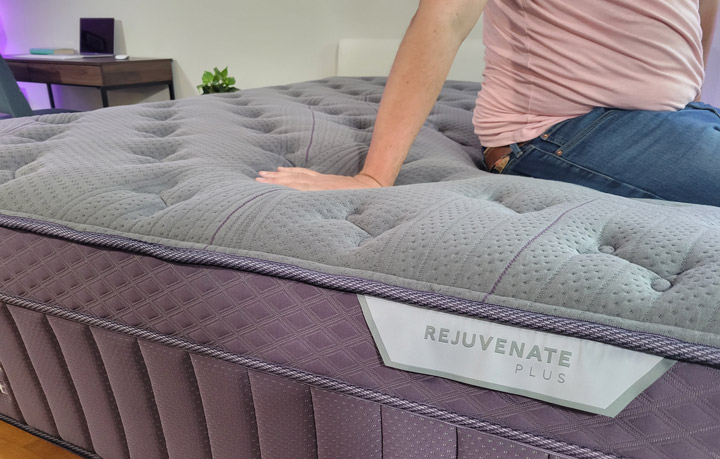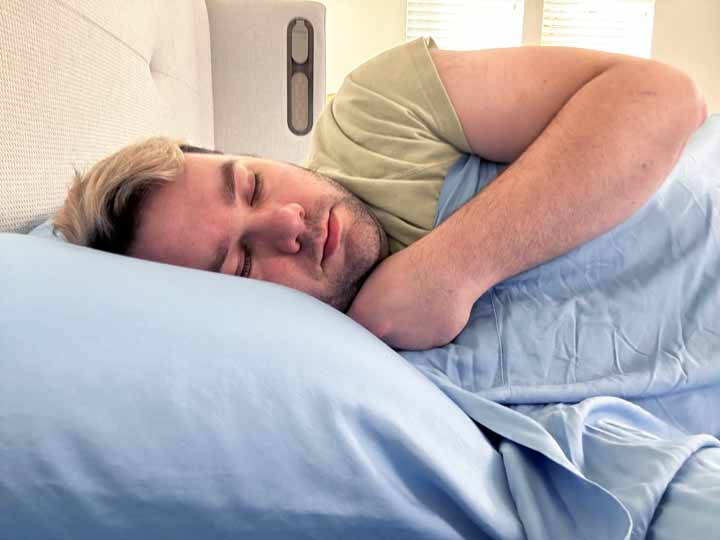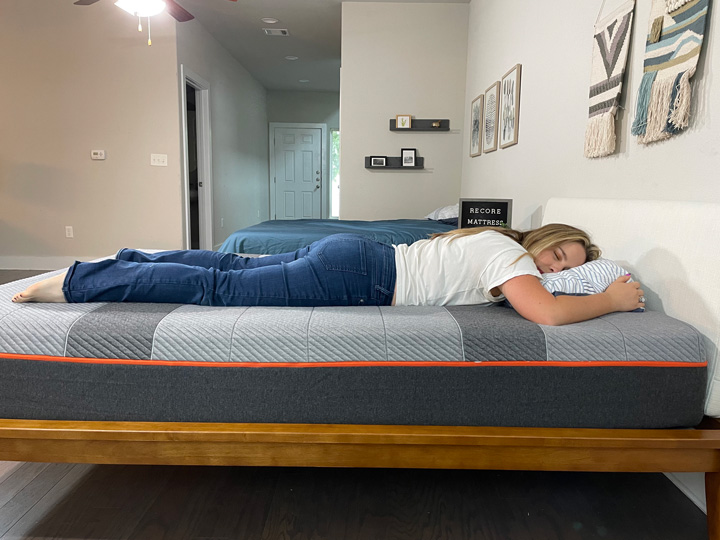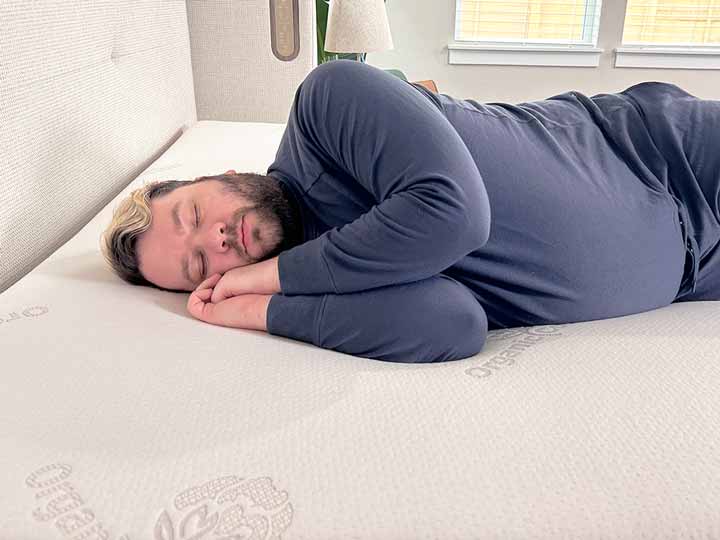If you want a mattress that hugs your joints and cradles your spine, you may want to look for something plush. These soft mattresses allow you to sink into the top layer, which can alleviate pressure and create an ultra-cozy feel.
While these softer-than-average beds offer exceptional pressure relief, they aren’t for everyone. Read on to learn more about plush mattresses, including where they fall on the firmness scale and who may want to get one.
Plush mattresses have a soft, enveloping surface that hugs the body. Thick foam layers offer exceptional pressure relief and can help isolate motion.
What Makes a Mattress Plush?
Only one thing makes a mattress plush: a soft comfort layer along the surface of the bed. All mattress types—including innerspring, memory foam, hybrid, and latex mattresses—can be plush.
Thick Comfort Layers
Plush mattresses have thick comfort layers—typically 3” or more. Thick foam layers let you sink into the surface of the mattress without hitting the support layers underneath.
Pillow Top
Some plush beds have a pillow top along the surface. A pillow-top mattress consists of a soft layer of padding, made of either foam or fiber, that’s sewn on top of the mattress. Pillow tops are often tufted, which offers cushioning and pressure relief.

Euro Top
Euro tops are similar to pillow tops, but there’s one main difference. Euro tops are sewn to the sides of the mattress, so they don’t have that same fluffy pillow top appearance. The difference in construction makes Euro tops feel less cushiony than pillow tops, but they can still offer pressure relief.
Who Should Get a Plush Mattress?
The cuddly comfort of a plush mattress may feel nice when you first lie down on a bed, but it’s not the best choice for every person. Let’s take a look at who should consider a softer-than-average mattress.
People with Joint Pain
If you deal with joint pain, you may need a mattress that offers pressure relief. The best mattresses for pressure relief have soft top layers that can cradle your hips and shoulders. The result? Less weight along your pressure points, which can help ease pain.
Side Sleepers
Most side sleepers need mattresses that cushion their shoulders and hips. If a side sleeper rests on a firm mattress, they may develop joint pain and sink out of alignment. Take a look at our list of the best mattresses for side sleepers for some good options.

Lightweight People
Lightweight people, those who weigh less than 130 lbs, don’t put much pressure on a bed’s surface. As a result, some mattresses often feel firmer to lightweight people.. Some of the best mattresses for lightweight people are softer-than-average, coming in at 6/10 on our firmness scale.
Who Shouldn’t Get a Plush Mattress?
Plush mattresses aren’t for everyone. If you fall into one of the following categories, you may not want to get a soft mattress.
Heavier People
People who weigh more than 230 lbs typically need supportive mattresses in order to maintain a neutral spine alignment. Additionally, many soft mattresses aren’t strong enough to handle heavier weights, so they could sag over time.
Some Back Sleepers
Many back sleepers prefer firm mattresses because they offer plenty of lower back support and can help keep the spine in alignment. Some lightweight back sleepers may get the support they need on a plush mattress, but it’s not common.
Stomach Sleepers
Generally, we don’t recommend plush mattresses to stomach sleepers. In this sleeping position, most people need a firm mattress in order to keep their hips elevated. Plush mattresses could cause your hips to sink out of alignment, which can put strain on the lower back.

What to Look For in a Plush Mattress
If you want to get a plush mattress, here are a few things you should look for.
Thick Comfort Layers
For a luxurious, pressure-relieving feel, you’ll want a mattress with thick comfort layers. I recommend looking for a mattress with at least three inches of foam in its comfort layer. Extra points if a bed has a pillow top or Euro top for added cushioning.
Firmness Level
We rate mattress firmness on a 1-10 firmness scale, with 1/10 being cotton-candy-soft and 10/10 being pavement-hard. Most soft mattress fans prefer a bed that falls at a 5.5/10 or 6/10. These beds deliver cozy cushioning without completely sacrificing support.
Edge Support
A common problem with softer beds is insufficient edge support. You don’t want to roll off the bed if you sleep along the edge. If edge support is important to you, I recommend the Plush Soft model of the Saatva Classic.
Motion Isolation
A perk that comes with thick comfort layers is above-average motion isolation. This means that one person (or pet) can move around on one side of the mattress without shaking someone else on the opposite side.
While most plush beds absorb motion well, some outperform others. The Nectar Premier is a mattress that earned high scores in both our pressure relief and motion transfer tests. It could be a good mattress for couples who love soft beds.
Cooling
A common problem with soft beds is that they tend to trap heat. As you sink into a cloud-like top layer, your body heat can build up due to insufficient airflow. Fortunately, there are plush mattresses that sleep cool. If you’re a hot sleeper, look for a soft hybrid or innerspring mattress. If you prefer all-foam beds, make sure the comfort layers are infused with cooling materials like gel, graphite, or copper.
If you’re looking for a cooling soft mattress, consider the WinkBeds GravityLux. It earned a spot as one of the best cooling mattresses in our best soft mattresses roundup.
Price
There are budget-friendly beds and pricey options. Expensive models often have thick comfort layers and feel more luxurious, but there are some excellent affordable mattresses as well. The Layla memory foam mattress is a good budget-friendly bed that has a plush feel.
Durability
Soft foam layers tend to wear out faster than firm foams. This is simply a result of durability correlating with density—less dense, soft foams are more prone to forming body impressions than dense, supportive foams.

There are a few things you can do if you worry about the longevity of a new mattress. First, check out the mattress’s warranty. A lifetime warranty shows a company’s confidence in the longevity of its beds. It’s also a good idea to regularly rotate your mattress so you aren’t always sleeping in the same spot.
FAQs
Is a plush mattress soft or firm?
A plush mattress is another term for a soft mattress. These beds boast generous cushioning and outstanding pressure relief. Most people will label a mattress as soft when it falls around a 5.5/10 or 6/10 on the firmness scale.
What are the disadvantages of a plush bed?
A plush mattress isn’t as supportive as a firmer bed. As a result, you might feel “stuck inside” a plush mattress and find it difficult to get in and out of bed. Additionally, softer beds don’t do a great job supporting the spine for stomach sleepers and heavier people.
Is a plush mattress good for back pain?
A plush mattress can be good for back pain if you’re a side sleeper or lightweight back sleeper. But for most people, a medium-firm mattress is best for back pain.
Can I make a plush mattress firmer?
While it’s easy to make a firm mattress softer with a plush mattress topper, it isn’t easy to make a plush mattress firmer. The best way to attempt this would be to add a firm latex topper on top of the soft bed. Latex is typically more supportive than memory foam.


